Experimental Investigation of Crack Extension Patterns in Hydraulic Fracturing with Shale, Sandstone and Granite Cores
Abstract
:1. Introduction
2. Experimental Methodology
2.1. Sample Preparation
2.2. Experimental Procedure
3. Results and Discussion
3.1. Characteristics of Rock Materials
3.2. Experimental Monitoring of Hydraulic Fracturing
3.3. Observations of the Induced Cracks
3.3.1. Macro-Observation of Induced Cracks
3.3.2. Micro-Observation of Induced Cracks
3.4. Crack Extension Patterns in Different Rock Cores
3.4.1. Hydraulic Fracture Propagation Pattern in Sandstone
3.4.2. Hydraulic Fracture Propagation Pattern in Shale
3.4.3. Hydraulic Fracture Propagation Pattern in Granite
3.4.4. Tortuosity Comparison of the Fractures in Sandstone, Shale, and Granite
4. Conclusions
- (1)
- The initial heterogeneities in rock materials—such as the laminated structure of shale, and the grain boundaries and pores in granite—play an important role in the propagation of hydraulic fractures. When the hydraulic fracture encounters a relative bedding plane in shale, the fracture may propagate along or across the bedding plane, or be arrested by it. Some micro-cracks were induced around the injection hole in the sandstone core.
- (2)
- CT scanning experiments demonstrate the spatial distribution of hydraulic fractures in fractured sandstone, shale, and granite cores. The crack extension in sandstone, shale, and granite cores are extremely different.
- (3)
- The results demonstrate that the tortuosity of fractures in fractured sandstone and shale cores are quite close, ranging from 1 to 1.1. However, the fractures in fractured granite core are more tortuous than that in fractured sandstone and shale cores, the fracture tortuosity ranges from 1.2 to 1.3. This may result from the different structure (initial heterogeneity) of the rocks.
Acknowledgments
Author Contributions
Conflicts of Interest
References
- The Future of Geothermal Energy: Impact of Enhanced Geothermal Systems (EGS) on the United States in the 21st Century. Available online: https://www1.eere.energy.gov/geothermal/pdfs/future_geo_energy.pdf (accessed on 6 October 2016).
- Lamont, N.; Jessen, F.W. The Effects of Existing Fractures in Rocks on the Extension of Hydraulic Fractures. J. Pet. Technol. 1963, 15, 203–209. [Google Scholar] [CrossRef]
- Blanton, T. An Experimental Study of Interaction between Hydraulically Induced and Pre-Existing Fractures. Soc. Pet. Eng. 1982. [Google Scholar] [CrossRef]
- Warpinski, N.R.; Teufel, L.W. Influence of geologic discontinuities on hydraulic fracture propagation (includes associated papers 17011 and 17074). J. Pet. Technol. 1987, 39, 209–220. [Google Scholar] [CrossRef]
- Lhomme, T.P.; de Pater, C.J.; Helfferich, P.H. Experimental study of hydraulic fracture initiation in Colton sandstone. In Proceedings of the SPE/ISRM Rock Mechanics Conference, Irving, TX, USA, 20–23 October 2002.
- Gale, J.F.; Reed, R.M.; Holder, J. Natural fractures in the Barnett Shale and their importance for hydraulic fracture treatments. AAPG Bull. 2007, 91, 603–622. [Google Scholar] [CrossRef]
- Zhou, J.; Chen, M.; Jin, Y.; Zhang, G.Q. Analysis of fracture propagation behavior and fracture geometry using a tri-axial fracturing system in naturally fractured reservoirs. Int. J. Rock Mech. Min. 2008, 45, 1143–1152. [Google Scholar] [CrossRef]
- Dehghan, A.N.; Goshtasbi, K.; Ahangari, K.; Jin, Y. Experimental investigation of hydraulic fracture propagation in fractured blocks. Bull. Eng. Geol. Environ. 2015, 74, 887–895. [Google Scholar] [CrossRef]
- Liu, Z.; Chen, M.; Zhang, G. Analysis of the influence of a natural fracture network on hydraulic fracture propagation in carbonate formations. Rock Mech. Rock Eng. 2014, 47, 575–587. [Google Scholar] [CrossRef]
- Chuprakov, D.; Melchaeva, O.; Prioul, R. Injection-sensitive mechanics of hydraulic fracture interaction with discontinuities. Rock Mech. Rock Eng. 2014, 47, 1625–1640. [Google Scholar] [CrossRef]
- Liu, E. Effects of fracture aperture and roughness on hydraulic and mechanical properties of rocks: Implication of seismic characterization of fractured reservoirs. J. Geophys. Eng. 2005, 2, 38–47. [Google Scholar] [CrossRef]
- Guo, T.; Zhang, S.; Qu, Z.; Zhou, T.; Xiao, Y.; Gao, J. Experimental study of hydraulic fracturing for shale by stimulated reservoir volume. Fuel 2014, 128, 373–380. [Google Scholar] [CrossRef]
- Fan, T.G.; Zhang, G.Q. Laboratory investigation of hydraulic fracture networks in formations with continuous orthogonal fractures. Energy 2014, 74, 164–173. [Google Scholar] [CrossRef]
- Bennour, Z.; Ishida, T.; Nagaya, Y.; Chen, Y.; Nara, Y.; Chen, Q.; Sekine, K.; Nagano, Y. Crack Extension in Hydraulic Fracturing of Shale Cores Using Viscous Oil, Water, and Liquid Carbon Dioxide. Rock Mech. Rock Eng. 2015, 48, 1463–1473. [Google Scholar] [CrossRef]
- Scholz, C.H. Experimental study of the fracturing process in britle rocks. J. Geophys. Res. 1968, 88, 555–568. [Google Scholar]
- Renard, F.; Bernard, D.; Desrues, J.; Ougier-Simonin, A. 3D imaging of fracture propagation using synchrotron X-ray microtomography. Earth Planet. Sci. Lett. 2009, 286, 285–291. [Google Scholar] [CrossRef]
- Chitrala, Y.; Moreno, C.; Sondergeld, C.H.; Rai, C.S. Microseismic mapping of laboratory induced hydraulic fractures in anisotropic reservoirs. In Proceedings of the Tight Gas Completions Conference, San Antonio, TX, USA, 2–3 November 2010.
- Stanchits, S.; Mayr, S.; Shapiro, S.; Dresen, G. Fracturing of porous rock induced by fluid injection. Tectonophysics 2011, 503, 129–145. [Google Scholar] [CrossRef]
- Brenne, S.; Molena, M.; Stöckert, F.; Alber, M. Hydraulic and sleeve fracturing laboratory experiments on 6 rock types. In Proceedings of the International Society for Rock Mechanics (ISRM) International Conference for Effective and Sustainable Hydraulic Fracturing, Brisbane, Australia, 20–22 May 2013.
- Li, X.; Feng, Z.; Han, G.; Elsworth, D.; Marone, C.; Saffer, D. Hydraulic Fracturing in Shale with H2O, CO2 and N2. In Proceedings of the 49th US Rock Mechanics/Geomechanics Symposium, San Francisco, CA, USA, 28 June–1 July 2015.
- Pradhan, S.; Stroisz, A.M.; Fjær, E.; Stenebråten, J.F.; Lund, H.K.; Sønstebø, E.F. Stress-Induced Fracturing of Reservoir Rocks: Acoustic Monitoring and μCT Image Analysis. Rock Mech. Rock Eng. 2015, 48, 2529–2540. [Google Scholar] [CrossRef]
- Shao, H.; Kabilan, S.; Stephens, S.; Suresh, N.; Beck, A.N.; Varga, T.; Martin, P.F.; Kuprat, A.; Jung, H.B.; Um, W.; et al. Environmentally friendly, rheoreversible, hydraulic-fracturing fluids for enhanced geothermal systems. Geothermics 2015, 58, 22–31. [Google Scholar] [CrossRef]
- Zhu, H.; Wang, Q.; Zhuang, X. A nonlinear semi-concurrent multiscale method for fractures. Int. J. Impact Eng. 2016, 87, 65–82. [Google Scholar] [CrossRef]
- Zhuang, X.; Huang, R.; Liang, C.; Rabczuk, T. A coupled thermo-hydro-mechanical model of jointed hard rock for compressed air energy storage. Math. Probl. Eng. 2014, 2014, 179169. [Google Scholar] [CrossRef]
- Ren, H.; Zhuang, X.; Cai, Y.; Rabczuk, T. Dual-horizon peridynamics. Int. J. Numer. Methods Eng. 2016, 108. [Google Scholar] [CrossRef]
- Mighani, S.; Sondergeld, C.H.; Rai, C.S. Observations of tensile fracturing of anisotropic rocks. SPE J. 2016, 21, 1289–1301. [Google Scholar] [CrossRef]
- Vernik, L.; Liu, X. Velocity anisotropy in shales: A petrophysical study. Geophysics 1997, 62, 521–532. [Google Scholar] [CrossRef]
- Hubbert, M.K.; Willis, D.G.W. Mechanics of hydraulic fracturing. Mem. Am. Assoc. Pet. Geol. 2013, 18, 153–163. [Google Scholar]
- Olson, J.E.; Bahorich, B.; Holder, J. Examining Hydraulic Fracture: Natural Fracture Interaction in Hydrostone Block Experiments. In Proceedings of the SPE Hydraulic Fracturing Technology Conference, The Woodlands, TX, USA, 6–8 February 2012.
- Chen, Y.; Nagaya, Y.; Ishida, T. Observations of Fractures Induced by Hydraulic Fracturing in Anisotropic Granite. Rock Mech. Rock Eng. 2015, 48, 1455–1461. [Google Scholar] [CrossRef]

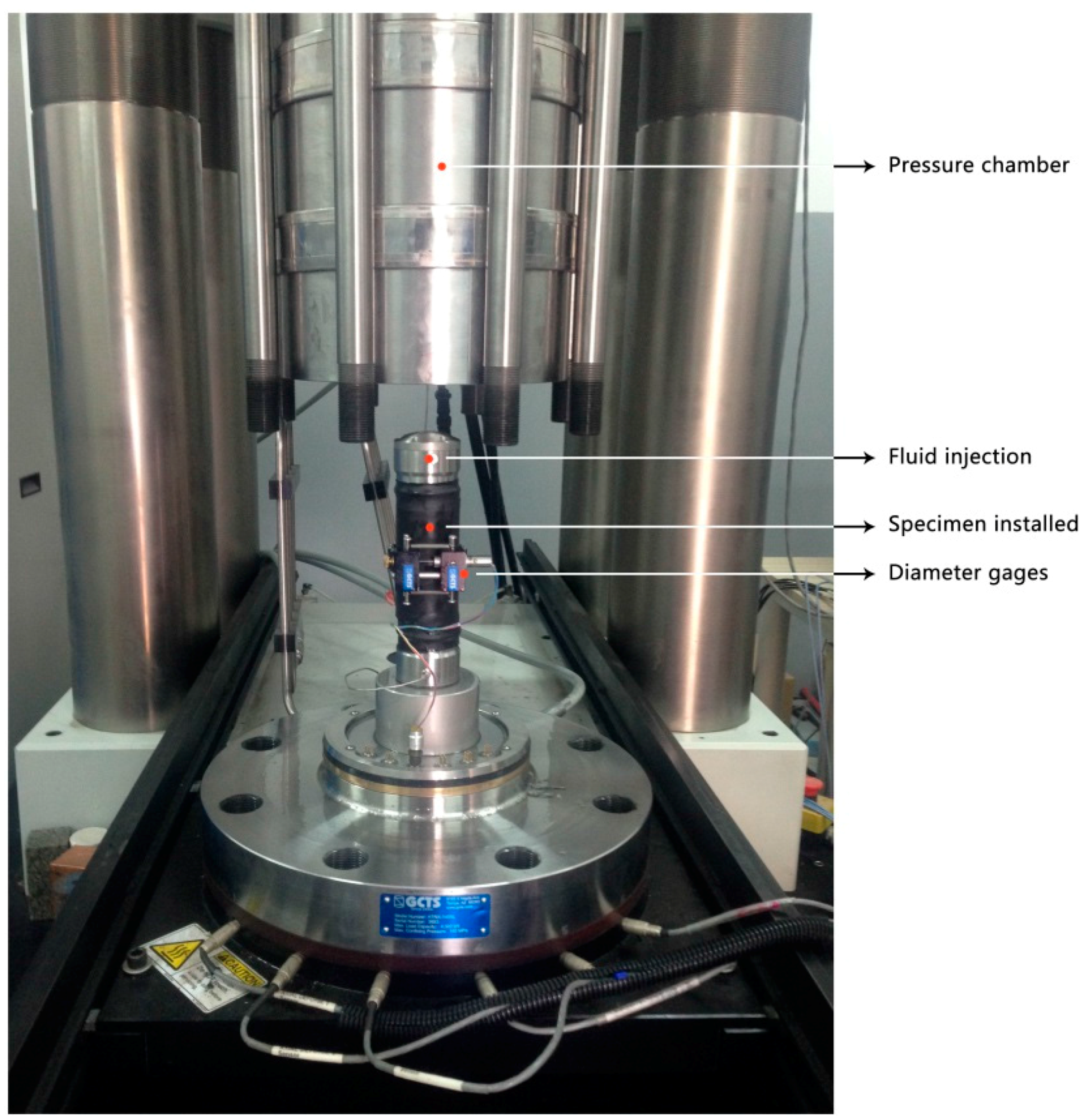
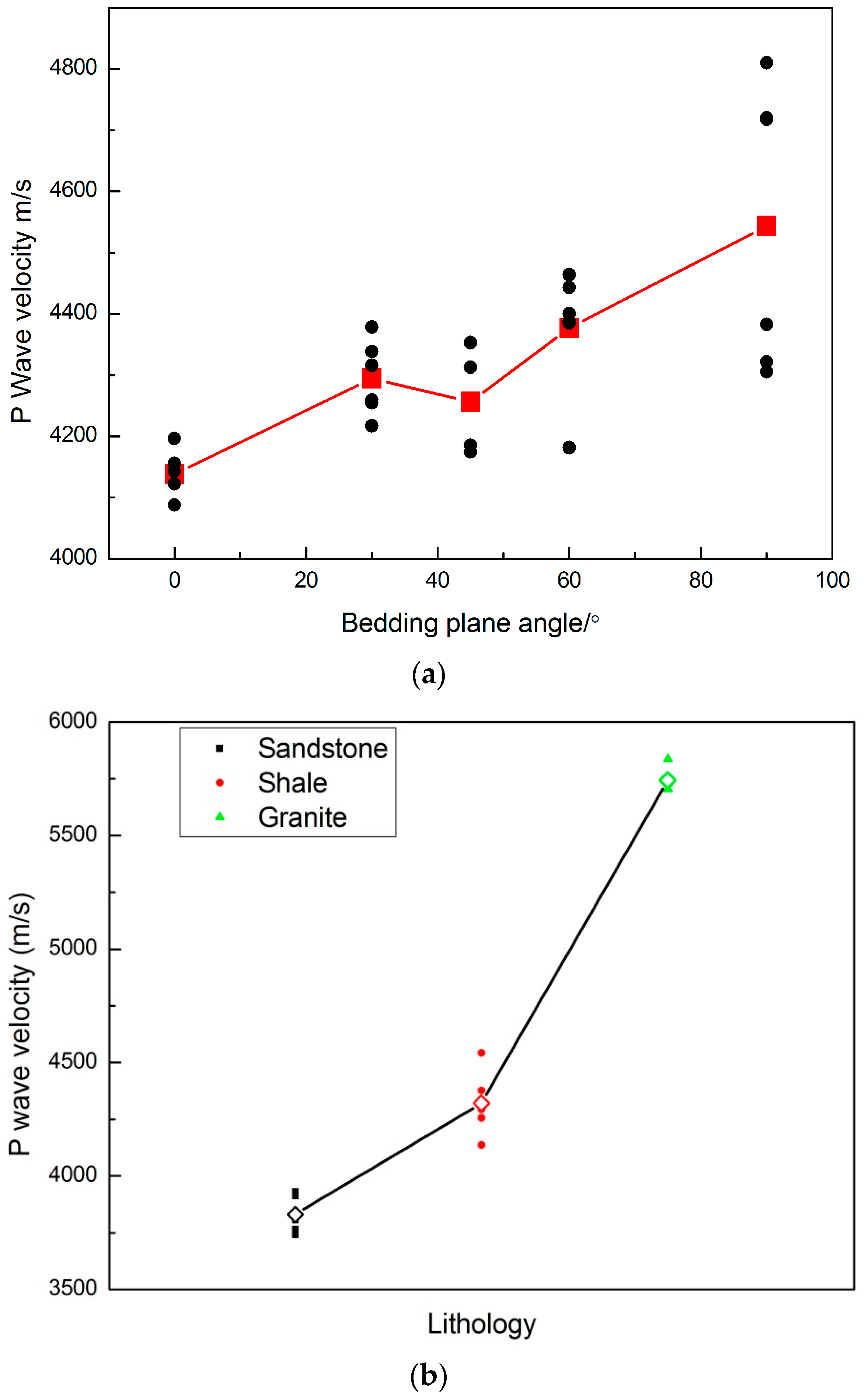
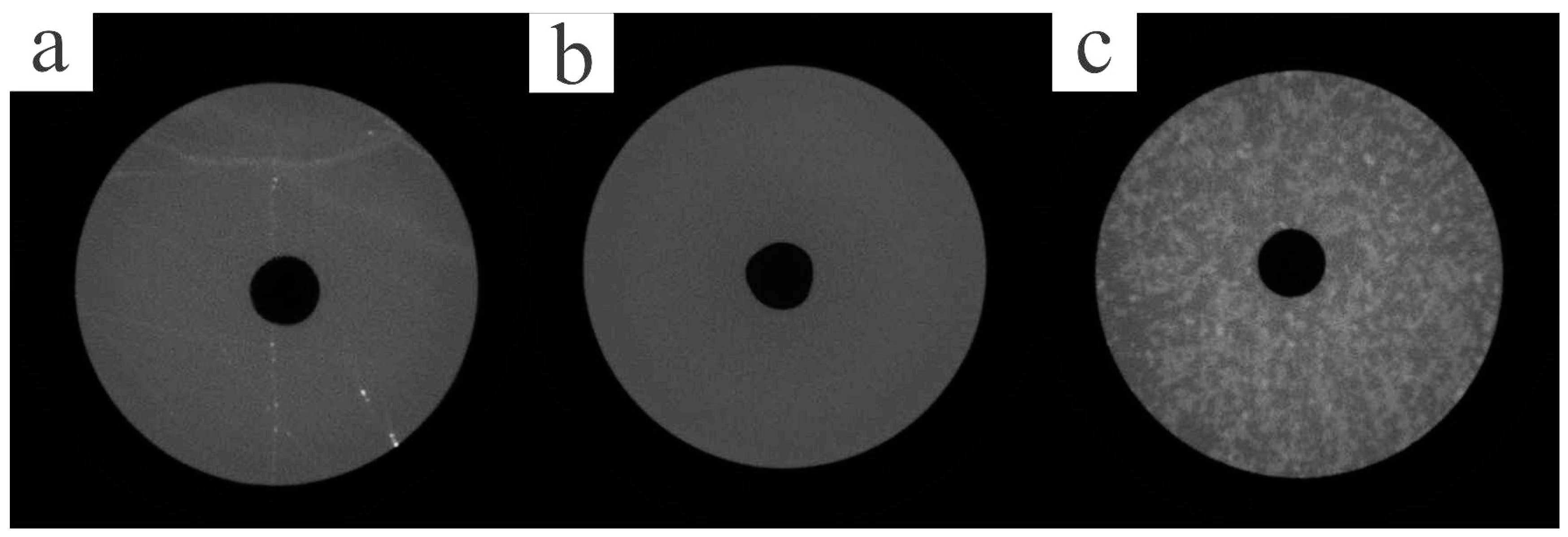

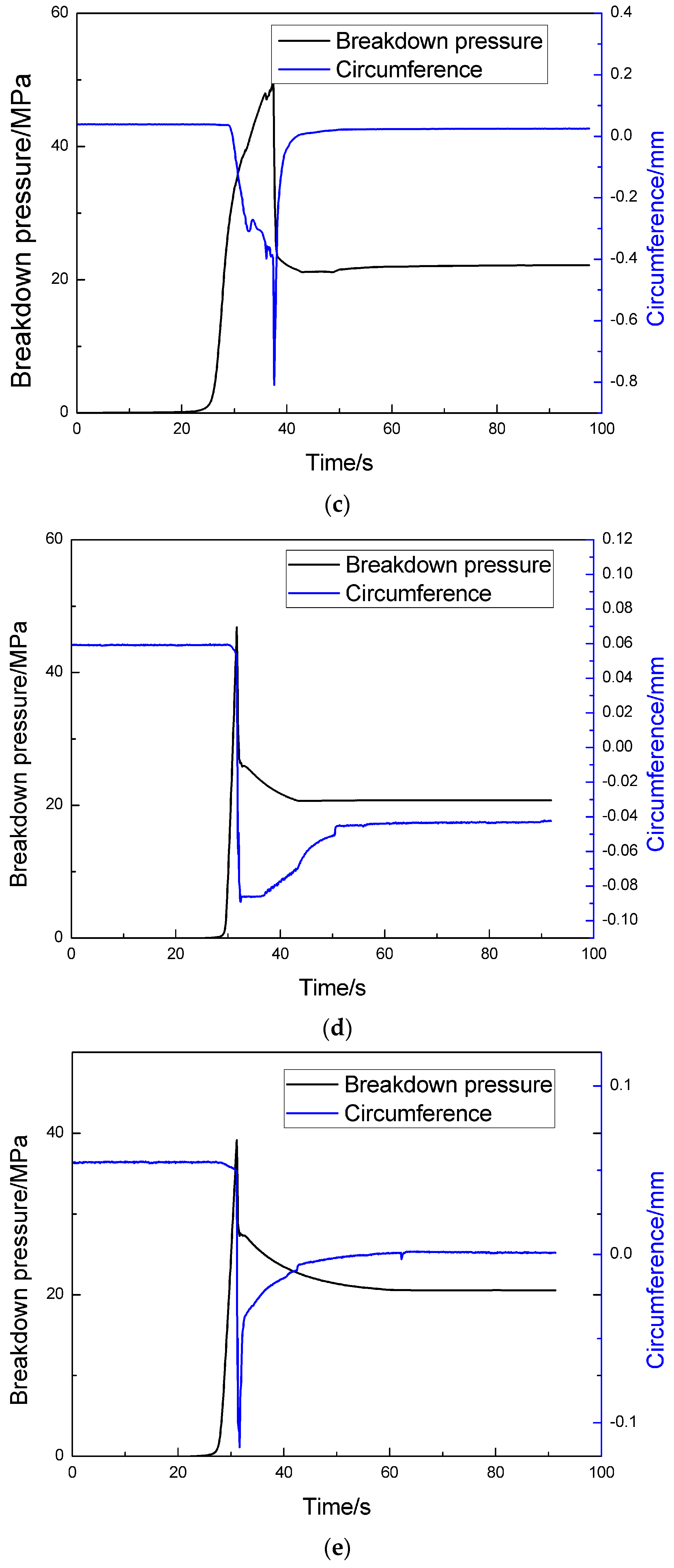
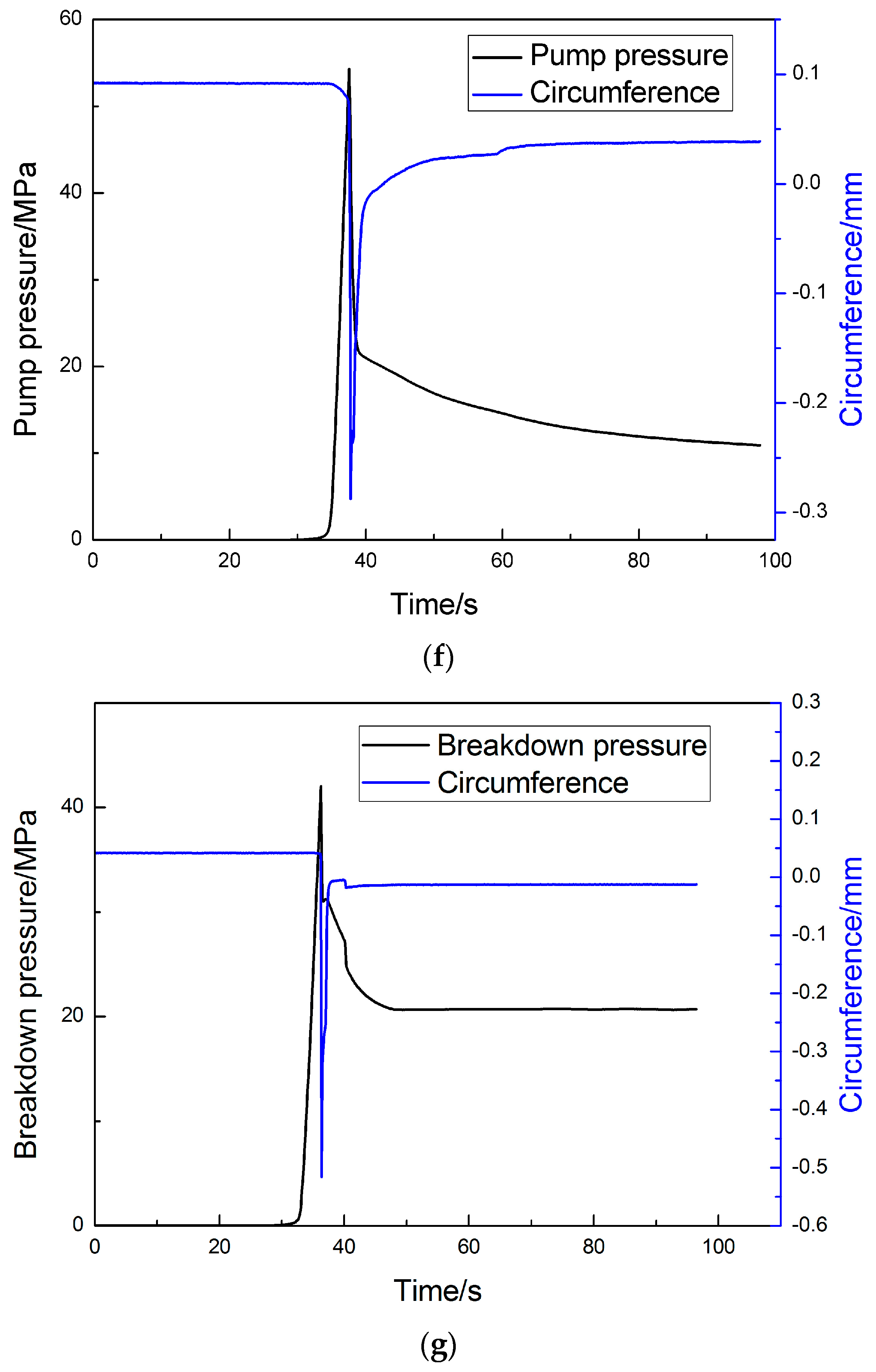
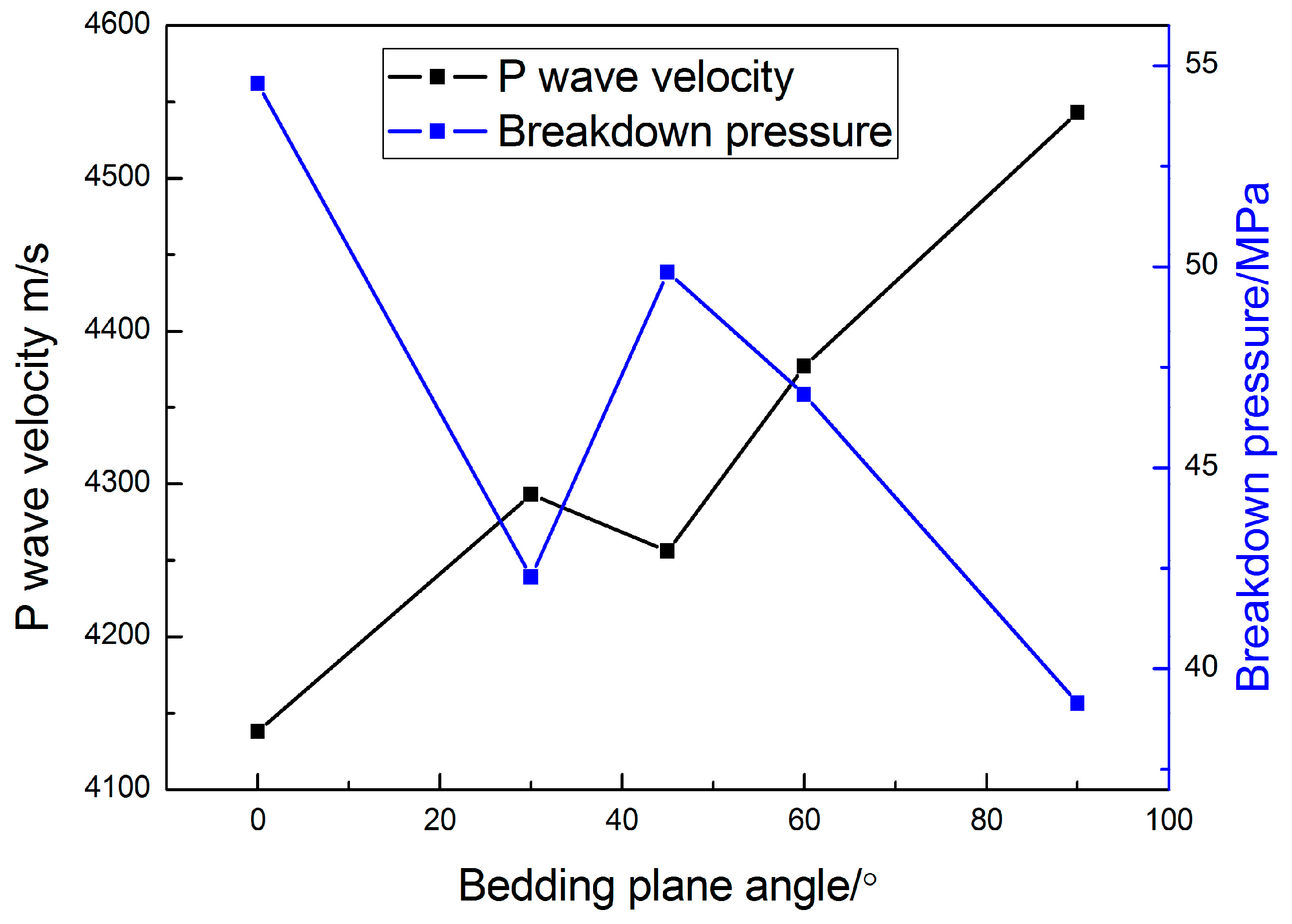

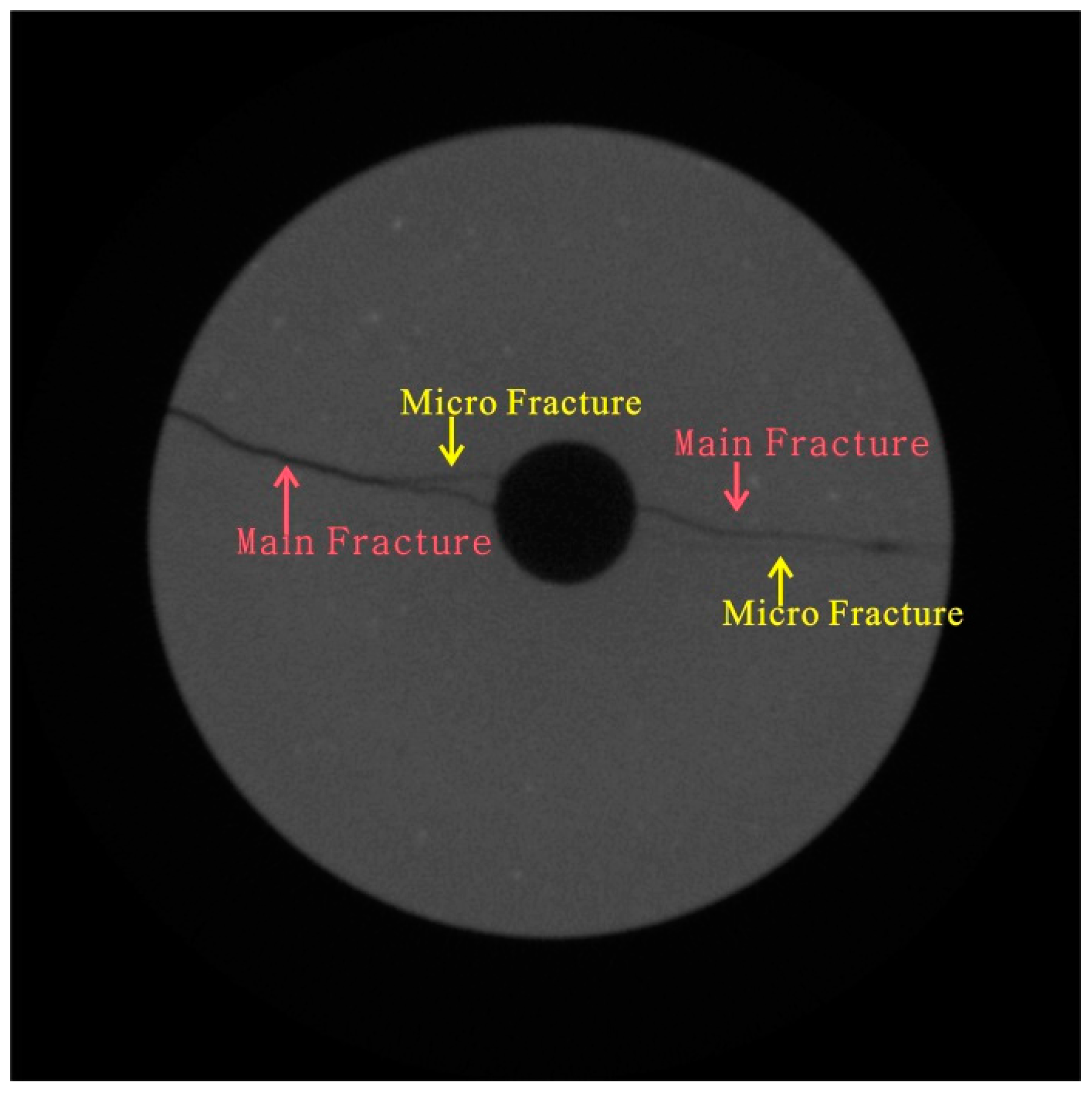
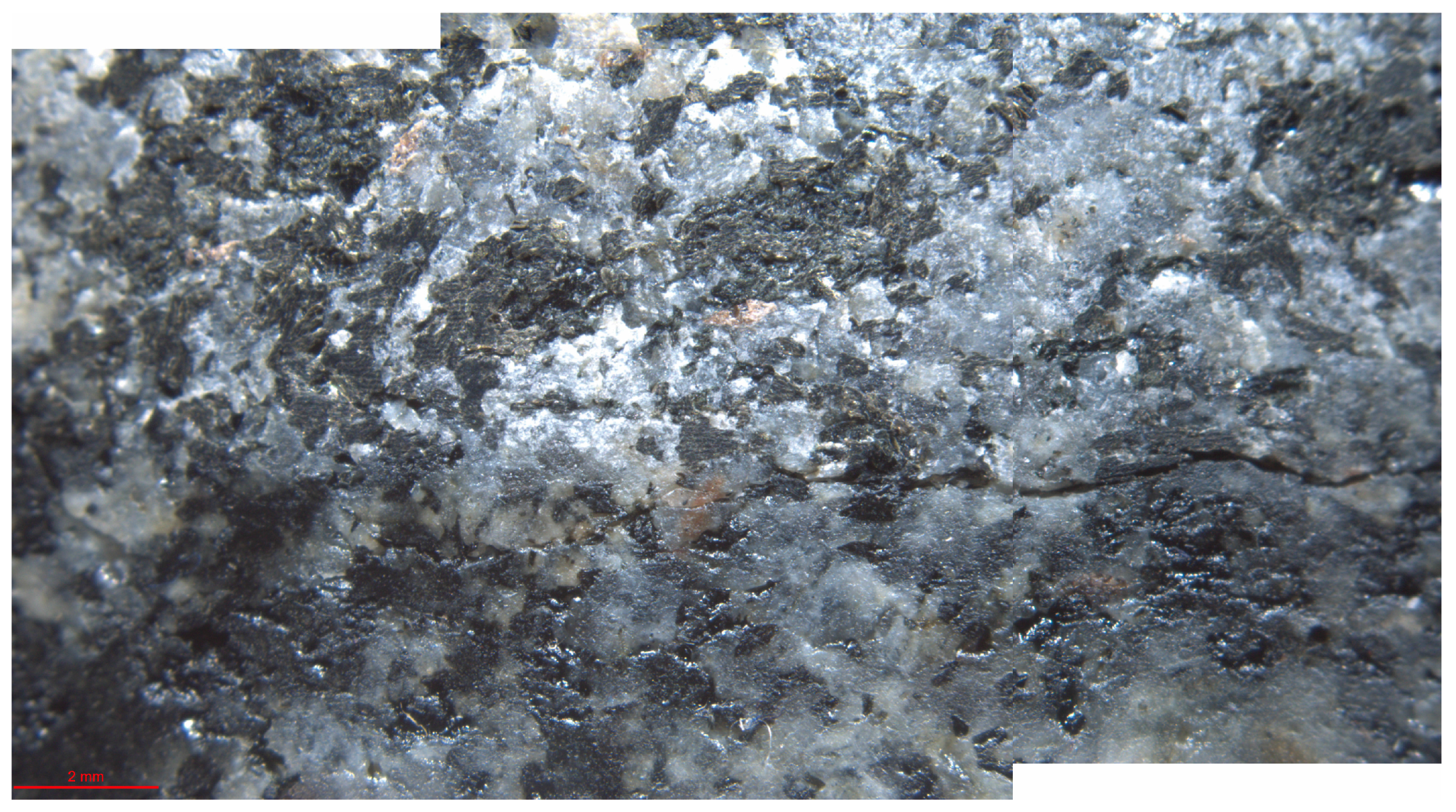
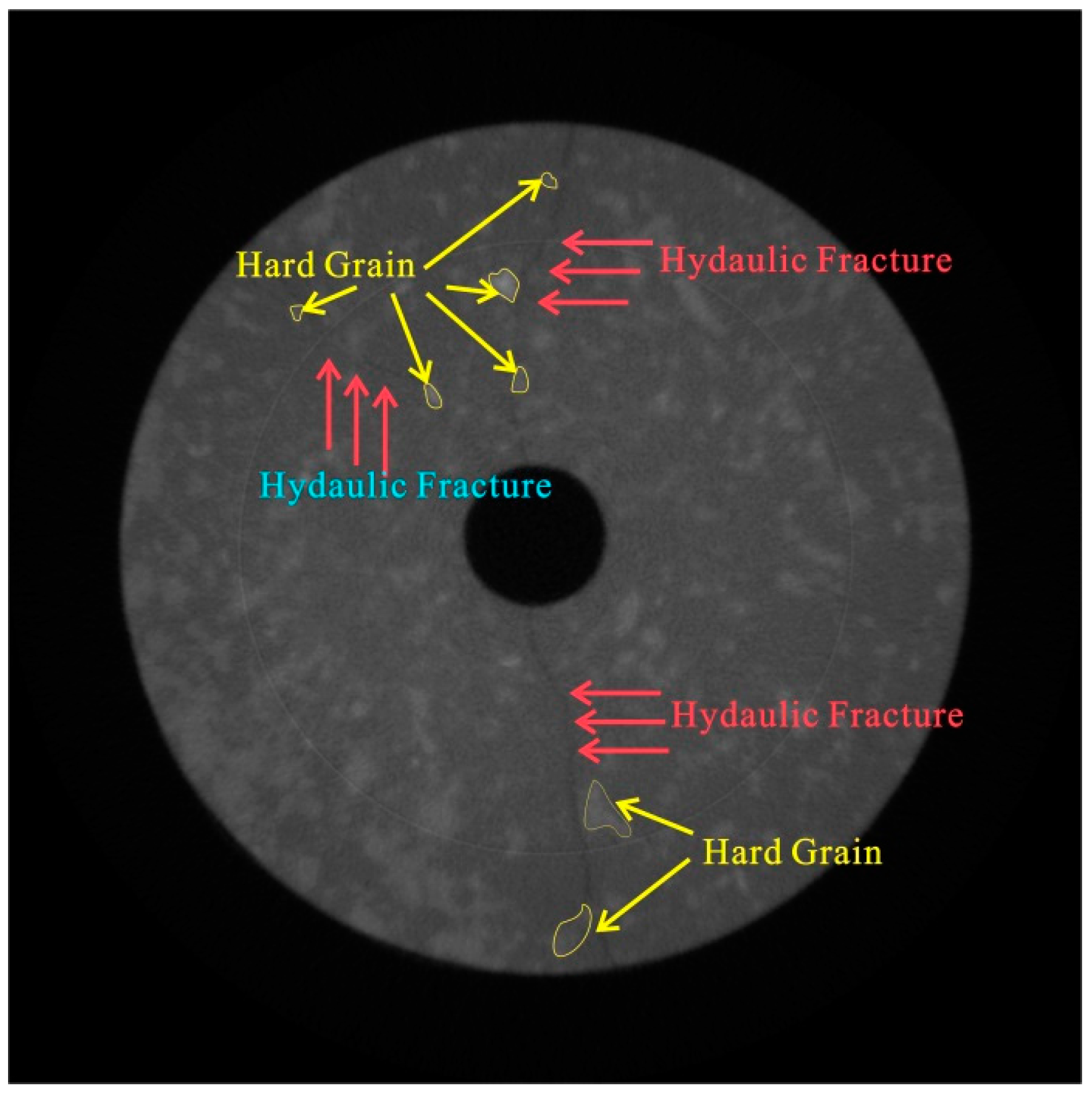
| Rock Type | Properties | |||||
|---|---|---|---|---|---|---|
| Bedding Plane Angle | Density (g/cm3) | Average P Wave Velocity (m/s) | Uniaxial Compressive Strength (MPa) | Tensile Strength (MPa) | Breakdown Pressure (MPa) | |
| Shale | 0° | 2.60 | 4138 | 125 | 7.07 | 54.56 |
| 30° | 2.66 | 4293 | 45 | 5.63 | 42.29 | |
| 45° | 2.61 | 4256 | 72 | 4.35 | 49.86 | |
| 60° | 2.64 | 4377 | 90 | 3.49 | 46.82 | |
| 90° | 2.62 | 4543 | 151 | 3.09 | 39.14 | |
| Granite | N/A | 2.78 | 5744 | 101.7 | 9.7 | 42 |
| Sandstone | N/A | 2.45 | 3831 | 65 | 6.4 | 54.32 |
© 2016 by the authors; licensee MDPI, Basel, Switzerland. This article is an open access article distributed under the terms and conditions of the Creative Commons Attribution (CC-BY) license (http://creativecommons.org/licenses/by/4.0/).
Share and Cite
He, J.; Lin, C.; Li, X.; Wan, X. Experimental Investigation of Crack Extension Patterns in Hydraulic Fracturing with Shale, Sandstone and Granite Cores. Energies 2016, 9, 1018. https://doi.org/10.3390/en9121018
He J, Lin C, Li X, Wan X. Experimental Investigation of Crack Extension Patterns in Hydraulic Fracturing with Shale, Sandstone and Granite Cores. Energies. 2016; 9(12):1018. https://doi.org/10.3390/en9121018
Chicago/Turabian StyleHe, Jianming, Chong Lin, Xiao Li, and Xiaole Wan. 2016. "Experimental Investigation of Crack Extension Patterns in Hydraulic Fracturing with Shale, Sandstone and Granite Cores" Energies 9, no. 12: 1018. https://doi.org/10.3390/en9121018
APA StyleHe, J., Lin, C., Li, X., & Wan, X. (2016). Experimental Investigation of Crack Extension Patterns in Hydraulic Fracturing with Shale, Sandstone and Granite Cores. Energies, 9(12), 1018. https://doi.org/10.3390/en9121018






